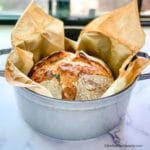Dutch Oven Sourdough Bread
Fluffy, tender and perfectly tangy dutch oven sourdough bread. This classic no knead sourdough recipe is easy and uses just 4 basic ingredients!
Servings: 12 slices
Calories: 292kcal
Equipment
- dough whisk optional
- 4 to 5 quart Dutch oven with lid
- parchment paper
Ingredients
- ¼ cup sourdough starter (65 grams) discard or fed 12-24 hours prior *see notes below
- 1 ⅔ cups filtered water (350 grams) about 100º F or baby bottle warm
- 4 ¼ cups all-purpose flour (500 grams) can substitute with bread flour
- 2 teaspoons fine salt (9 grams)
Instructions
- In a large bowl, add the sourdough starter. Add in water and use a dough whisk or a wooden spoon to stir until dissolved. Stir in the flour and salt until a shaggy looking dough forms. Finish mixing dough by hand in the bowl until all the flour has been absorbed. Cover the bowl with a clean, damp kitchen towel and let the dough rest for 30-45 minutes.
- Lightly flour your countertop. Pull the dough from the bowl with a dough scraper or by hand onto the countertop. Stretch and fold the dough for 15 seconds (see video below): grab the edge of the dough and bring it straight up it about 4 inches and tuck it into the center of the dough. Then, turn the dough 1/4 a turn. Continue this process until the dough has come full circle and it has tightened.Return the dough to the bowl, cover with a damp towel (or plastic wrap if you live in a dry area) and and let rise at room temperature or a warm area 4-12 hours (see chart in notes) to ferment. Do not refrigerate the dough. The dough should be about double in size and look puffy on the surface and bubbly under the dough when fermented.
- Lightly flour your countertop. Pull the dough from the bowl and shape the dough by stretching and folding it again. Let the dough rest 10 – 15 minutes. Line a medium sized bowl with a towel, or use a banneton bowl with linen cover (see photos), and dust heavily with flour. Let dough rise in it for 45-60 minutes.
- Preheat your oven to 450ºF. Do not add your Dutch oven or baking pot to the oven, it does not get preheated.Cover the dough bowl with a long piece of parchment paper, about 20 inches long, and turn it over onto the countertop (see video). Slash the top of the loaf with a lame or sharp serrated knife. Gently lower the parchment paper dough into a heavy pot with a tight-fitting lid. NOTE: If using a Dutch Oven with a dark interior, see recipe notes below.
- Place the covered pot in the the oven and bake the bread covered for 30 minutes. Remove the lid and bake 20 minutes. Using oven mitts, carefully remove the bread from the pot. Bake it directly on the oven rack for 5-10 minutes to crisp the exterior (if needed). To ensure your bread is cooked through you can check the internal temperature. It should be 195ºF to 205ºF.
- Let cool for at least 1 hour before serving.
Video
Notes
FOR GRAMS MEASUREMENTS click on the METRIC tab above ingredients.
This recipe uses a discard or unfed sourdough starter, which means one that was fed 12-24 hours before starting the recipe. Our recipe does not use a starter that's at its peak when mixing the dough. A 100% hydration sourdough starter works best for this recipe.
Recipe Variation:
- If you prefer extra tangy sourdough bread, replace 1/4 teaspoon (up to 1/2 teaspoon) of the salt with citric acid or sour salt for a tangy kick to your bread.
- 80ºF about 4-5 hours
- 75ºF about 6-7 hours
- 70ºF about 8-9 hours
- For temperatures under 70ºF it can take up to 12 hours or more
- Place the bowl in the oven with the door closed and light on to create a slightly warmer climate without actually turning the oven on.
- Use a heated mat (like those used for germinating seeds) for rising.
- Use the "proof" setting of your oven (I set mine to 85ºF) and set a timer. This will speed up the rising process, so check it at 4 and 6 hours.
- If there is a sunny room in the house that stays warm, keep the dough covered in that area.
- I use a 9" round Silpat silicone sheet in my dark-bottomed cast iron pots. Place it in the bottom of your pot before adding the dough.
- Or add a layer of foil and an extra layer of parchment paper in the bottom of your cast iron pot.
- Check to see if the top of the loaf is golden and if it sounds hollow when tapped on.
- Check the internal temperature in the center of the bread. It should 195º – 200ºF when done.
- Let the bread cool completely. Store it in a plastic bag at room temperature. I use a plastic bread bag with a twist tie to seal it and it stays fresh for about 5 days.
- This bread is great to freeze. Place in an airtight bag and store in the freezer for up to 3 months.
- Check out our in-depth guide on how to store fresh sourdough bread for more storage tips.
Nutrition
Serving: 1slice | Calories: 292kcal | Carbohydrates: 41g | Protein: 8g | Fat: 1g | Saturated Fat: 1g | Polyunsaturated Fat: 1g | Monounsaturated Fat: 1g | Sodium: 242mg | Potassium: 84mg | Fiber: 2g | Sugar: 1g | Calcium: 13mg | Iron: 4mg
